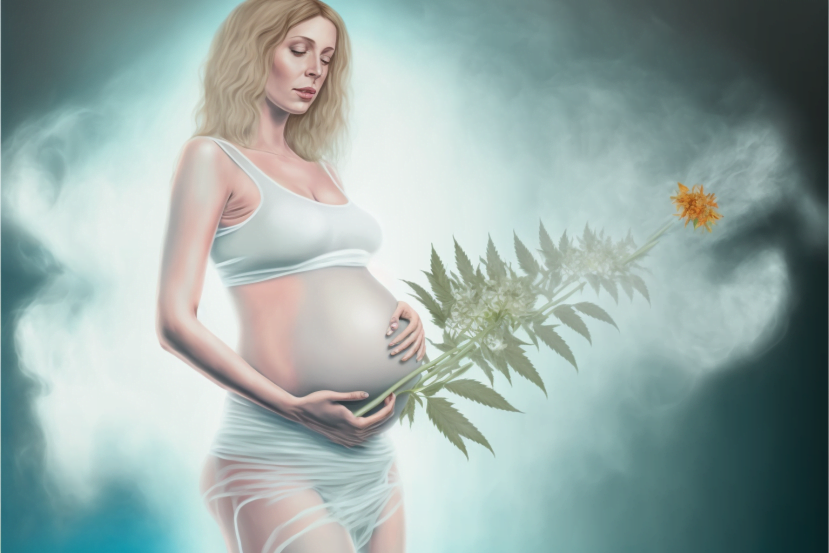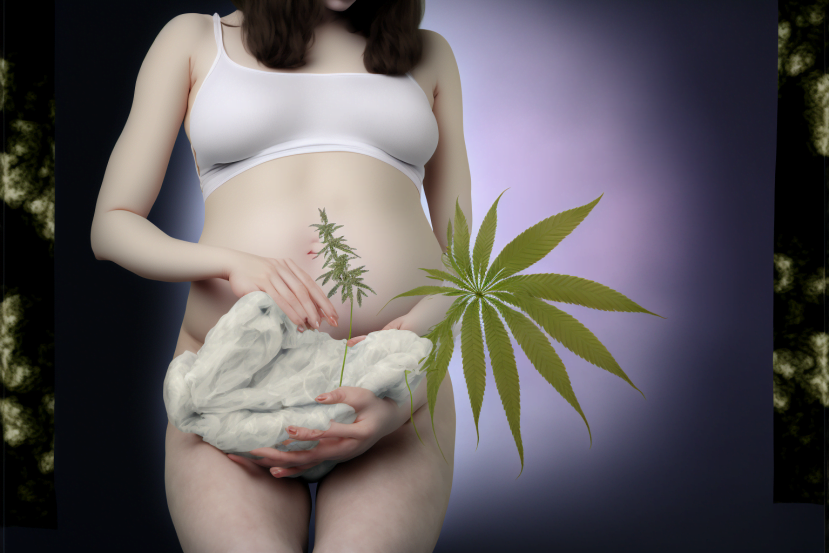English
Many pregnancy-related symptoms such as increased stress levels, repeated bouts of nausea and reduced appetite are often effectively controlled by cannabis in non-pregnant individuals. But is the use of cannabis a useful therapeutic strategy for expectant mothers who experience problems during and after pregnancy?
In addition, pregnancy-related complications do not simply disappear once the baby is born. Many mothers suffer from severe anxiety and depression after the birth, they are in pain and sleep badly.
What is the risk of cannabis use to the developing foetus?
In a 2020 study conducted in California, about 11% of women reported using cannabis during pregnancy, almost double the pre-legalisation levels: 6% versus 11%. However, a major limitation of this epidemiological study is that it does not control for cannabis composition – it is not variety-specific and does not control for THC content.
This is just one of many studies that are limited because they do not capture CBD use or reliably account for the use of additional drugs such as nicotine and caffeine. Consequently, it is difficult to analyse the effects of cannabis alone on birth outcomes and child development.
The effects of cannabis use during pregnancy on the developing fetus and the child’s behaviour later in life are inconsistent. In part, the timing of cannabis use during pregnancy may be associated with unique effects. The cannabinoid type I receptors (CB1), which THC activates to produce a feeling of intoxication, are not present in the foetus until the 19th week of pregnancy.
In rhesus monkeys, THC easily crosses the placenta and can be detected in the blood of the foetus within 15 minutes of consumption by the mother. This is not to say that the foetus can become stoned; it is not until the third trimester that the foetus’ brain has the necessary structures for this effect, and even then it would be a very different experience.
Nevertheless, the CB1 receptors and the rest of the endocannabinoid system play an important role in brain development. For example, they can influence how brain cells develop, tell them where to go, which cells to connect to and what they should look like. The activation of CB1 receptors plays an important role in brain development, which could be significantly disrupted by THC if the mother consumes cannabis during pregnancy. At least that is the theory.
An alarming study of nearly 25 000 mothers found that 500 children born to cannabis-using mothers had lower weights, were more likely to be born prematurely (i.e. were preterm) and were more likely to be admitted to the neonatal intensive care unit. Interestingly, these effects also occurred when factors such as socioeconomic status were taken into account.
Furthermore, these negative effects disappeared if the mother had traditionally used cannabis and stopped during pregnancy, suggesting that cannabis directly affects fetal development.
It is noteworthy that these results have not been consistently replicated. A recent 2020 study of mothers from California found no clear impact of cannabis use on these neonatal outcomes. Taken together, these findings underscore the wide variability in the effects of cannabis on the fetus and developing child.
Does diet have an influence?
Firstly, these are only observational studies and do not take into account things like frequency of use, dosage or lifestyle differences such as diet. While there is limited research on how diet interacts with cannabis and affects the developing fetus, one study found a possible protective effect of dietary choline against harm from THC exposure during pregnancy.
Choline is an essential nutrient found in many foods such as eggs, meat and potatoes. While the body can make its own choline, this is usually not enough, especially for the developing brain, which needs choline to synthesise an important developing brain chemical, acetylcholine.
A team led by Dr Camille Hoffman, a consultant gynaecologist and obstetrician in Denver, Colorado, tracked maternal choline levels in over 130 women since 2013 and examined their newborns after birth. Although they found that cannabis use during the first trimester was associated with behavioural problems, the infants of cannabis-using mothers with the highest choline levels had better self-regulation, higher attention spans, cuddled more and bonded better with their parents.
In an interview with Dr Hoffman, she points out that increasing choline in the diet is not a sure way to be safe. However, based on her research, Dr Hoffman recommends that expectant mothers consume about 900 mg of choline daily, either through food or supplements, to mitigate the potentially harmful effects of THC exposure during pregnancy.
Cannabis and other substances
Referring to research on moderate cannabis use in pregnant mothers, Dr Hoffman noted that the observed effects on the foetal brain are still very subtle. “People make all kinds of good or bad decisions, and [cannabis] doesn’t seem to be as bad as [other drugs],” she said.
“Yes, there is new data to suggest that we should exercise caution … But it’s probably not as bad as the things we know are harmful, like alcohol.”
However, there are some factors that exacerbate the effect of cannabis on the developing foetus. Dr Hoffman pointed out that using multiple substances can be much worse than using just one. In one study, for example, the simultaneous use of tobacco and cannabis had twice the effect on the infant’s ability to self-soothe compared to infants who used only tobacco.
While this effect was more pronounced in girls, another study found that co-use of tobacco and cannabis in boys led to greater dysregulation of the infant’s stress response – boys born to mothers who used cannabis and tobacco had a 35% lower cortisol response than mothers who used tobacco alone, and a 22% lower response than non-users. Why concurrent tobacco use worsens outcomes in a gender-specific manner remains unknown, but it highlights the potential problems with using multiple substances to treat symptoms.
While many mothers take multiple medications to treat pregnancy-related symptoms – e.g. anxiety, nausea, sleep – Dr Hoffman points out that the interactions between all these medications can carry their own risks.
The effects of cannabis on brain development and mental health
Many studies on laboratory animals have shown that THC has harmful effects on brain development. However, in many cases, these are studies that only map the extreme use of high THC concentrations and not the more common patterns of use of conventional cannabis as a whole plant.
Nevertheless, the studies highlight the vulnerability to THC of brain regions involved in impulse control, executive functions, emotional development and reward processing. Consistent with the effects of THC on these brain regions, several of the more comprehensive assessments of cannabis use in pregnancy have found that children of cannabis-using mothers are more likely to be impulsive, hyperactive, have poorer abstract reasoning and executive functions.
The child’s mental health may also be affected by maternal cannabis use. Ten-year-old children in one cohort self-reported higher levels of depression if their mothers were heavy cannabis users in the first trimester. This is notable because about 70% of Colorado dispensaries recommend cannabis during the first trimester to combat nausea.
Many parents are rightly concerned about the long-term behavioural consequences of cannabis use, but controlled human experiments are unlikely in the future. Correlation does not equal causation, so care must be taken when assigning causal blame to a single factor in complex behavioural outcomes.
Although some are trying to limit the risk by switching to products with higher CBD content, scientists still know little about the long-term consequences CBD has on the more than 65 targets in the brain and body of the foetus. While the harmfulness of maternal cannabis use is by no means proven, there is also no clear evidence of safety.
What is the exposure risk for a child from passive smoking of marijuana?
Even after birth, the newborn can come into contact with cannabis via breast milk and passive smoking. In one study, THC and its metabolites were detected in adults in trace amounts from passive smoking of cannabis. While these small amounts are unlikely to have any effect on a child, repeated exposure to cannabis smoke can build up over time due to the fat solubility of THC and other cannabinoids.
Another study showed that although THC transmission from secondhand smoke was low, at 11.3% THC, it was sufficient to cause mild subjective effects in adults. However, these effects could be minimised by improved room ventilation.
What is the risk of exposure from breast milk?
Breast milk is another source of cannabinoid transmission to the infant. THC can be detected in breast milk up to 6 days after smoking. In some cases, however, there is no transfer of THC at all. It is currently unclear what factors cause THC to be transferred in some cases but not in others.
The proportion of THC that is transferred also varies. One study found that the breast milk of mothers who regularly used cannabis contained 2.5% of the 0.1 grams of about 23.2% THC-rich cannabis they inhaled. THC was detected within the first 20 minutes after inhalation and peaked about one hour after consumption. Importantly, the variability in THC transmission between mothers was immense, ranging from 0.4% (little) to 8.7% (a lot).
At present, there are no clear predictions of where people will fall on this spectrum, but it is estimated that the dose to which an infant is exposed is about 1,000 times lower than that to which the mother is exposed. Whether this has a significant effect on the child’s brain development is not known.
Could cannabis help?
Despite the risk of cannabinoid transmission to the infant, there is not always a simple right or wrong answer to the question of whether to use. Maternal bonding and infant care can be influenced by a number of factors, including the mother’s mental health and well-being.
Up to 85% of new mothers experience the ‘baby blues’ within a few weeks of giving birth, and around 15% develop clinical postpartum depression within the first year. Anxiety, poor sleep and postpartum pain add to the postpartum challenges.
The most effective and safe strategies need to be selected, weighing up the risks and benefits. Although there is growing evidence that these symptoms can be treated with CBD, there is still far too little research into the developmental effects of this cannabinoid compared to the known effects of THC.
As with many health and safety aspects of cannabis, there is no definitive evidence that guarantees its safety or harmfulness. Instead, the true effects probably lie somewhere between alarmist views propagated by medically conservative sources and the very vocal “cannabis is perfectly safe” faction. Despite decades of observing children and studying the effects of cannabis on laboratory animals, our understanding of the effects of cannabis on the developing human brain is still in its infancy.
Did you find this article Cannabis during and after pregnancy helpful? Then you might be interested in this article :
Pregnant cannabis – users should know about toxicology tests
Published by Sakul
31/01/2023choose and buy cannabis seeds from our offer
our pleasure


























